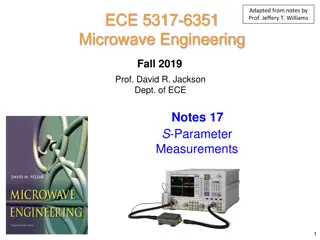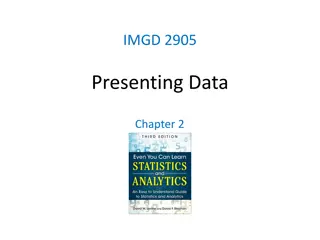Understanding Smith Charts in Microwave Engineering
Explore the concepts of Smith Charts in microwave engineering, focusing on the Generalized Reflection Coefficient, Complex Plane representation, Z-Chart analysis, and equation derivations for circles in the Z-Plane. Learn how to interpret impedance transformations and visualize impedance matching using these powerful graphical tools.
Download Presentation

Please find below an Image/Link to download the presentation.
The content on the website is provided AS IS for your information and personal use only. It may not be sold, licensed, or shared on other websites without obtaining consent from the author. Download presentation by click this link. If you encounter any issues during the download, it is possible that the publisher has removed the file from their server.
E N D
Presentation Transcript
Adapted from notes by Prof. Jeffery T. Williams ECE 5317-6351 Microwave Engineering Fall 2019 Prof. David R. Jackson Dept. of ECE Notes 5 Smith Charts 1
Generalized Reflection Coefficient ( ) I z + ( ) Z 0, Z V z L + Z Z Z Z z z = = 0 0 L L 0 L Recall: ( ) ) ( ) ( ) ( ) z + + + = + = + 2 z z z 1 1 V z V e e V e 0 0 L + + V Z V Z ( ( ) ( ) I z ( ) z + = = 2 z z z 1 1 e e e 0 0 L 0 0 ( ) ( ) I z ( ) ( ) z + + + 1 1 2 V z z z 1 1 e e ( ) = = = Z z Z Z L 0 0 + 2 z L ( ) z 2 z + = e Generalized reflection Coefficient: L 2
Generalized Reflection Coefficient (cont.) Different forms for (z) Magnitude property of (z) ( ) z + = 2 z e Z Re 0 1 L L L + = = 2 j z e e L L ( ) z ( ) z + j Proof: R I ( ( ( ( ) ) + + + + + + R R jX jX Z Z = 0 L L L 0 L L Lossless transmission line ( = 0) ) ) R R Z Z jX jX = 0 L L ( ) z ( ) + 2 j z = e L 0 L L L ( ( ) ) 2 + + + 2 L R R Z Z X X 2 = 0 L 1 L 2 2 L 0 L 3
Complex Plane ( ) ( ) R = = z ( ) z + z j Increasing d (moving towards generator) I Im ( ) + 2 j z = e L ( ) + 2 j z = e L Clockwise movement! L ( ) 2 j d = e 2 d L L L ( ) 2 j d = e L L L Re 2 d L Lossless line 1 = z d Note: d = distance from load Going /2 on the line corresponds to going all the way around the Smith chart. 4
Z Chart Start with ( ) ( ) z + 1 1 z The Zchart is the usual Smith chart. ( ) = Z z Z 0 ( ) Z ( ) ( ) z + 1 1 Z z z ( ) z = Z Define n 0 = + Z R jX Note: n n n The z dependence is being suppressed here. Hence we have: ( ( ) ) + + + 1 1 j j + = R I R jX n n R I Next, multiply both sides by the RHS denominator term and equate real and imaginary parts. Then solve the resulting equations for Rand Iin terms of Rn or Xn. This gives two equations. 5
Z Chart (cont.) 1) Equation #1: 2 2 1 R + + = 2 I n R R + 1 1 R n n I R = 0 n R 1 Equation for a circle in the plane n nR = 1 1 nR R + = ,0 n R Center 1 1 n 1 R = Radius + 1 R n 6
Z Chart (cont.) 2) Equation #2: 2 2 1 1 ( ) 2 + = 1 R I X X n n I X = 0 1 X 1 Equation for a circle in the plane n n 1 X n 1 = 1, Center X 1 n 1 X = 0 = Radius n R X n 1 X n 0 1 X n X = 1 n 7
Z Chart (cont.) Short-hand version Xn= 1 Rn= 1 Xn= -1 plane plane 8
Z Chart (cont.) Imag. (reactive) impedance Inductive (Xn > 0) plane plane Xn= 1 Rn= 1 Short ckt. ( = 1) Match pt. ( =0) Open ckt. ( =1) Real impedance Xn= -1 Capacitive (Xn < 0) 9
Admittance Calculations with the Z Chart ( ) ( ) z + 1 1 z 1 1 Z ( ) = = Note: Y z ( ) Z z 0 ( ( ) ) ( ) ( ) z + 1 1 z ( ) = Y 1/ Y Z 0 0 0 ( ( ) ) ( ) ( ) z ( ) Y + 1 1 z Y z ( ) ( ) z ( ) = = + Y z G jB z n n n 0 Define: ( ) z ( ) z Conclusion: + 1 1 ( ) = n Y z The same Smith chart can be used as an admittance calculator. + 1 1 ( ) z Same mathematical form as for Zn: = Z n 10
Admittance Calculations with the Z Chart (cont.) Imag. (reactive) admittance Capacitive (Bn > 0) plane plane Bn= 1 Gn= 1 Open ckt. ( = 1) Match pt. ( =0) Short ckt. ( =1) Real admittance Bn= -1 Inductive (Bn < 0) 11
Impedance or Admittance Calculations with the Z Chart Normalized impedance or admittance coordinates The Smith chart can be used for either impedance or admittance calculations, as long as we are consistent. The complex plane is either the plane or the plane. 12
Y Chart As an alternative way to do admittance calculations, we can continue to use the original plane, and add admittance curves to the chart. ( ) ( ( ) ( 1 z ) ) + 1 z ( ) ( ) z ( ) = = + Y z G jB z n n n Compare with previous Smith chart derivation, which started with this equation: ( ( ) ) ( ) ( ) z + 1 1 z ( ) z ( ) ( ) z = = + Z R z jX n n n ( ) ( ) z ( ) ( ) z R z G z ( ) z ( ) z n n (rotation of 180o) X B n n Rn= 1circle, rotated 180o, becomes Gn= 1circle. Xn= 1circle, rotated 180o, becomes Bn= 1circle. Examples: Side note: A 180o rotation on a Smith chart makes a normalized impedance become its reciprocal. 13
Y Chart (cont.) Gn = 0 Inductive (Bn< 0) plane plane Bn = -1 Gn = 1 Match pt. Short ckt. Bn = 0 Open ckt. Bn = +1 Capacitive (Bn > 0) The Ychart is the mirror image of the usual Smith chart. 14
Y Chart (cont.) Short-hand version Bn= -1 Gn= 1 Bn= 1 plane 15
All Four Possibilities for Smith Charts Z chart, used for impedance 1 Z chart, used for admittance 2 The first two are the most common. The third is sometimes convenient. The fourth is almost never used. plane plane Y chart, used for admittance Y chart, used for impedance 3 4 plane plane 16
ZY Chart Short-hand version Inductive Bn= -1 Xn= 1 Gn= 1 Rn= 1 Xn= -1 Bn= 1 Capacitive plane This is convenient for doing matching problems that involve both series and shunt elements (done later). 17
Standing Wave Ratio The SWR is given by the value of Rn on the positive real axis of the Smith chart (Rnmax). Proof: + 1 1 ( ) z = L SWR L L ( ) ( ) z e e + 1 1 z = Z = max n R R n n + j z + + 2 1 1 + = = 2 0 z L + 2 z L + j z 2 L L + j z 2 j 1 1 e e e e L = L plane + j z 2 j + L 1 1 L + = = max n L 2 0 z R L L 18
Electronic Smith Chart At this link: http://www.sss-mag.com/topten5.html Download the following zip file: smith_v191.zip Extract the following files: smith.exe mith.hlp smith.pdf This is the application file 19
Example 1 ( ) I d = = 50 100 Z Z 0 + 50 j + L ( ) Z V d L d = Find at (- ) Z d / 1/ 4, 3/8, 1/ 2 z g z = 0 = z d Use the Z chart. = 3/8 d g 0 = 1/ 2 or d g X = 1 Z Z n = = + 2 1 j Z L Z chart , L n R = 1 0 n b Z Z L , L n n a = / 4 d g a 0.4 0.2 Z j n ( ) / 4 20 10 j Z g plane X = 1 n = / 4 d g 20
Example 1 (cont.) ( ) I d b = + 3/8 d g + ( ) 0.5 0.5 Z j Z V d n L ( ) 3/8 + z 25 25 Z j g z = 0 = z d 3/8 0.212 0.5 0.087 + = Note: = 3/8 d g 0 = = / 2 g d 0.087 g 0.212 g Z chart c Z b L n = + g g c /2 d 0.5 g 0.0 0.5 g 2 1 j Z n ( ) a = + /2 100 50 Z j g plane 0.462 g = / 4 d g 21
Example 2 ( ) I d ( ) = = = 50 8mS 20mS Z Y Y j 0 0 4mS + ( ) Z V d L L z d = Find at (- ) Y d / 1/ 4, 3/8, 1/ 2 z = g 0 = z d Use the Y chart. = 3/8 d g 0 = 1/ 2 or d g B = 1 Y Y n = = 0.4 0.2 Y j L , L n Y chart 0 G = 1 n b L Y Y , L n n a c a = + /4 d g 2 1 j Y n ( ) + /4 40mS 20mS Y j plane g B = 1 = / 4 d n g 22
Example 2 (cont.) ( ) b I d = 3/8 d g + ( ) 1 1 j Y Z V d n L ( ) 3/8 z 20mS 20mS Y j g z = 0 = z d = 3/8 d g 0 = 1/ 2 or d g c B = 1 n = / 2 d g Y chart G = 1 0.4 0.2 Y j n n ( ) = / 2 8mS 4mS Y j b L Y Y g , L n n c a plane B = 1 = / 4 d n g 23
Example 3 Use a short-circuited section of air-filled TEM, 50 transmission line ( = k0, g = d= 0) to create an impedance of Zin = -j25 at f = 10 GHz. Use the Z chart. 25 50 ( ) = = 0.5 Z j j Z chart , in n 50 = 25 Z j in 50 , k SC 0 SC g 0 L -1/2 = = = 0.426 0 0.426 0.426 L 0 g g g 2 k 2 c f = = = 0.426 g = 3.0 cm 0 0 0 0 0 plane L= 1.28cm 24
Example 4 Use an open-circuited section of 75 (Y0 = 1/75 S) air-filled transmission line at f =10 GHz to create an admittance of Yin = j1/75S: Use the Y chart. Y chart ( ) ( ) 1 = = 1/75 S Y j Y j , in in n 1/75 S B = 1 n 75 , k OC 0 L OC = = 0.125 0.125 = L 3.0 cm j1 n B = 1 0 g 0 L= 0.375cm L plane 25
Example 5 Single-stub matching Z = 50 0 d = + 100 100 j Z L Z Z 0 L = Choose Z Z 0 0 s = + 2 2 Z j In this example we will use the usual Smith chart (Z chart), but as an admittance calculator. Z , L n 0s sl We want Gin = Y0 (Gin,n = 1) 1 ( ) = = 0.25 .25 Y j , L n + 2 2 j + + 1 1 Z Z Z Z Z Z = = = = /6 o j 0.62 0.62 30 0 e L Ln L L 0 L Ln 26
Example 5 (cont.) + + = = 0 0 .0 .0 4 4 1 1 0.17 0.32 8 2 0.2 0.3 1 6 9 3 g Solution: g = = Add or at at - 1.57 j = + 0.219 Y d n g 0.178 g 1.57 j = 0.363 Y d n g Z chart (We ll use the first choice.) + 1 1.57 j SC OC 0.041g G = 1 plane n 1 1.57 j = 0.25 0.25 Y j , L n Smith chart scale: 0.322 g wavelengths toward load wavelengths toward generator 27
Example 5 (cont.) From the Smith chart: Z chart = 0.09 l s g Analytically: ( ) sc in = tan Z jZ l 0 s 0.25 S / C O / C g ( l ) sc in = = cot Y jY l 0 s ( ) cot B , s n s 0.09g 0 1.57 j = = 1.57 cot l s 1 = = cot 1.57; tan 0.637 l l plane s s 0.34 1.57 g 2 ( ) 1 = = = tan 0.637 0.567 [rad] l l s s wavelengths toward generator g = 0.0903 l s g 28
Example 5 (cont.) Single-stub matching Z = 50 0 = + d 100 100 j Z L Z Z 0 L Z Summary: 0s sl = 0.219 d g = 0.09 l s g 29























